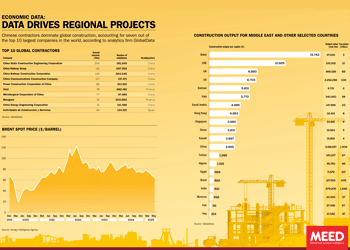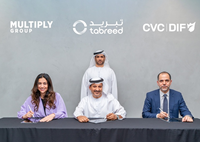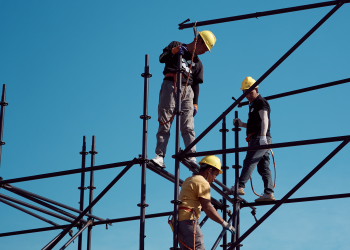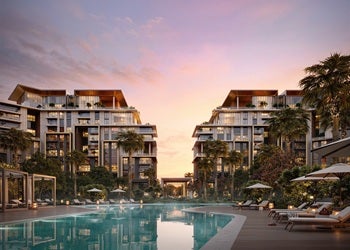Bridging the infrastructure capacity gap
2 April 2024

The Middle East and North Africa (Mena) region faces a massive infrastructure gap, with estimates of the shortfall ranging from $75bn to $100bn annually.
This translates to a cumulative need for $2-2.5tn in infrastructure investment alone by 2050. Bridging this funding gap will require a drastic increase in the level of investment.
In 2020, the World Bank stated that Mena countries needed to spend at least 8.2% of GDP to meet their infrastructure goals through to 2030. However, it had been averaging a spend of just 3% over the prior decade – mostly from public sector funds, alongside multilateral and bilateral debt financing.
In the intervening years, the additional fiscal constraints imposed by the pandemic and global economic shocks, such as food price inflation, have further hindered regional public spending on infrastructure.
In 2023, the ICD-Refinitiv OIC Infrastructure Outlook valued the region’s outstanding funding gap for infrastructure development at $994bn. The gaps included a $685bn shortfall in investment in road infrastructure; a $111bn funding gap in the water sector; a $65bn gap in telecoms; $47bn in rail; $34bn in port infrastructure; $27bn in electricity network investment; and $25bn in airport infrastructure investment.
This funding gap has real, material impacts on economic prosperity and the prospects for economic growth. The shortfall in investment in road infrastructure, for example, is estimated to cost the Mena region a staggering 5.5% in GDP a year due to inefficiency and accidents, according to the World Bank.
A 2020 study in the Review of Middle East Economics and Finance found that manufacturing firms in the Mena region faced the most severe durations of power outages a month of any region, at 64 hours a month. The perceived value of the business losses due to these power outages was estimated to be around 4.8% of total sales.
Meeting the region’s annual investment needs could generate about 2 million direct jobs and 2.5 million direct, indirect and induced infrastructure-related jobs, according to the OECD.
This is critical when half of the region’s population is under 24 years old, and 29% are not in employment, education or training, as per the OECD figures.
Another very tangible infrastructure gap is water capacity. The current annual water shortage in the Mena region is about 42 cubic kilometres, but by 2050, this is projected to grow fivefold to 199 cubic kilometres a year under average climate scenarios and potentially up to 283 cubic kilometres a year under drier conditions.
These examples highlight the need for substantial investments to bridge the infrastructure deficiencies, ensure the conditions for economic growth, and enhance overall sustainability in the Mena region.
To address the challenges, a comprehensive and multi-faceted approach is needed to incentivise the private sector to support regional infrastructure investments. This includes governments establishing clear policy directions and regulatory frameworks to attract private capital mobilisation.
This funding gap has real, material impacts on economic prosperity and the prospects for economic growth
Technological adaptation
In parallel with the need for governments to proactively improve the conditions for investment, the delivery of future infrastructure requirements also anticipates the adoption of emerging technology.
The goal of many countries to achieve net zero by 2050 also layers further complexity onto existing infrastructure challenges. Regional efforts such as the Middle East Green Initiative and the Circular Carbon Economy framework nevertheless demonstrate the region’s commitment to achieving its net-zero targets.
Reaching net zero will entail building infrastructure that is not just bigger and better, but smarter. At the Global Infrastructure Initiative Summit hosted by McKinsey in Dubai in February, disruptive thinking and technology were identified as vital to the industry’s evolution to meet the needs of a net-zero future.
Industry leaders called for a nuts-and-bolts overhaul of the industry from the bottom up, with more sustainable alternatives to even centuries-old staples such as Portland cement and rebar. The digitalisation of the industry and the advent of machine-learning and AI also hold huge potential for cutting waste and designing more organic, efficient structures.
The summit highlighted that solving future infrastructure requirements will also likely necessitate overcoming technology hurdles and bringing costs down through research and development, much like the costs of solar power or reverse osmosis desalination have come down in the region.
Alistair Green, a senior partner in McKinsey’s global infrastructure practice, pointed to the technologies that “are not at conviction, yet: the technology hasn’t even really been proven outside of the lab – like flow batteries, which are an alternative to lithium-ion batteries that can be used for grid-scale storage of long duration, energy storage. This is a technology problem that we’re actively investing in researching in order to bring the costs down.”
Strategy& and engineering consultancy Dar recently reported that sustainable construction technologies can potentially reduce lifecycle emissions from the Mena region’s $2tn construction pipeline through to 2035 by 50%-60% for planned projects. Simple changes can be highly effective, such as incorporating dynamic facades into building designs, which can deliver energy savings of up to 55% in hot countries.
The key is the level of innovation, not the level of technology. In the right application, a low-tech solution may be more efficient. If a low-tech solution is scalable, it is also likely to be more cost-efficient.
In the arid Ait Baamrane region of Morocco, a 2015 project by the NGO Dar Si Hmad has created the world’s largest operational fog-harvesting system, providing potable water using a system of shore-side nets that capture and condense the fog rolling in off the ocean. Launched after a decade of research, the system yields approximately 22 litres of water a day for each square metre of net. It demonstrates that infrastructure does not need to be expensive or complex to have a positive sustainability outcome.
The most pressing need for the Mena region is to improve the attractiveness of its infrastructure investment opportunities
Accessing finance
Without sufficient finance, the effectiveness of infrastructure development, including technological innovation within the sector, will be throttled. The most pressing need for the Mena region is to improve the attractiveness of its infrastructure investment opportunities.
Many governments, especially in the Gulf, have been focused on encouraging the private sector through better and wider public-private partnership (PPP) arrangements, with mixed results. Some countries have struggled to deliver PPP frameworks with sufficient commercial appeal and bankability, a problem usually linked to unattractive risk allocations on the private sector side.
Nevertheless, the mobilisation of PPPs and the creation of more transparent and efficient regulatory frameworks around them are routinely identified as vital for attracting and mobilising private capital.
The delivery of more sustainable infrastructure with a view to net-zero targets also brings the potential to tap into green finance, including green bonds and sharia-compliant sukuk. Projects targeted towards carbon neutrality open themselves up to more diverse avenues of potential finance, including international climate mitigation and adaptation funds.
Multilateral development banks, such as the Asian Infrastructure Investment Bank, support initiatives like the Catalyst Mena Climate Fund 2, which works to mobilise private capital for infrastructure projects focused on renewable energy, sustainable utility schemes and green hydrogen capacity.
Governments in the region are also taking steps to mobilise climate finance by issuing green sovereign bonds and sukuk to fund clean transportation, waste management and green building schemes.
The UAE’s infrastructure development is guided by the Green Agenda 2030 policy framework. Under this aegis, UAE banks, including Mashreq Bank and First Abu Dhabi Bank, have pledged to mobilise $270bn in green financing by 2030 for environmentally impactful projects.
Infrastructure financing schemes are an important step towards drawing more private sector liquidity into the infrastructure industry, but it is also just a start compared to what will be required to deliver the region’s infrastructure needs.
Deep regional inequality also needs to be addressed. While countries such as Saudi Arabia and the UAE may currently be meeting the World Bank’s 8.2% of GDP infrastructure spending targets, the region’s hydrocarbon importers will likely need far more outside assistance.
For the region as a whole to thrive, countries will also need to work together and synergistically to deliver holistic infrastructure roadmaps. Just as the GCC is working together to deliver the Gulf Railway, the Levant and North Africa must work together to develop their shared infrastructure.
Only through cooperation and joint initiatives will the Mena region stand to bridge its infrastructure gap.
Exclusive from Meed
-
 June 2025: Data drives regional projects
June 2025: Data drives regional projects30 June 2025
-
 UAE-Turkiye financial links strengthen
UAE-Turkiye financial links strengthen30 June 2025
-

-
 Iraq approves Basra housing project
Iraq approves Basra housing project30 June 2025
-
 Meraas announces Dubai City Walk expansion
Meraas announces Dubai City Walk expansion30 June 2025
All of this is only 1% of what MEED.com has to offer
Subscribe now and unlock all the 153,671 articles on MEED.com
- All the latest news, data, and market intelligence across MENA at your fingerprints
- First-hand updates and inside information on projects, clients and competitors that matter to you
- 20 years' archive of information, data, and news for you to access at your convenience
- Strategize to succeed and minimise risks with timely analysis of current and future market trends

Related Articles
-
 June 2025: Data drives regional projects
June 2025: Data drives regional projects30 June 2025
Click here to download the PDF
Includes: Top 10 Global Contractors | Brent Spot Price | Construction output
To see previous issues of MEED Business Review, please click herehttps://image.digitalinsightresearch.in/uploads/NewsArticle/14171168/main.gif -
 UAE-Turkiye financial links strengthen
UAE-Turkiye financial links strengthen30 June 2025
 This package on UAE-Turkiye relations also includes:
This package on UAE-Turkiye relations also includes:> UAE-Turkiye trade gains momentum
> Turkiye’s Kalyon goes global

Turkish bank DenizBank is one of Turkiye’s leading private banks and, as a wholly owned subsidiary of Emirates NBD since 2019, it is playing a leading role in developing business links between the UAE and Turkiye.
Recep Bastug, who was appointed as DenizBank’s CEO in 2024, says there is great potential for trade between the two countries.
“Turkiye is a growing country,” he says. “We’ve had volatility over the past five years, but the Turkiye economy and the banking sector have been able to manage those periods successfully.”
Having spent years with international institutions such as BBVA, Bastug has vast experience in the banking sector. “Turkish banks, especially private ones like DenizBank, are very successful. In terms of capital, balance sheet structure and digital transformation, we are in a strong position,” he says.
 Solid fundamentals
Solid fundamentalsTurkiye’s fundamentals remain solid with a diversified export-oriented economy, a young and skilled population of 85 million, and relatively low debt levels. “We are not a highly leveraged country. Our household debt-to-GDP ratio is low. With the right policy mix, we offer high potential for foreign investors,” says Bastug.
That potential is increasingly being realised through growing engagement with the GCC and the UAE. “Turkiye’s connection with the Gulf is going up, and DenizBank is set to play a serious role in these relations. Day by day, Turkish companies are expanding their footprint in the region.”
GCC projects
Baştug says that many of these companies approach DenizBank to help facilitate their entry into Gulf markets. “Some of our clients are extremely well capitalised, but others need support for major projects. Just recently, one Turkish company announced a $3bn project in the region. We’re helping them connect with Emirates NBD and navigate the local financial landscape.”
DenizBank is actively supporting the creation of trilateral partnerships – particularly between Turkiye, the UAE and Saudi Arabia. “We see huge opportunity in forming financial strongholds across these markets, leveraging Turkiye’s contractor experience, the UAE’s capital and Saudi Arabia’s scale,” says Baştug.
DenizBank is already delivering results. “With Emirates NBD, we’ve identified 10 strategic cooperation areas, including trade finance, payments and capital markets. Thanks to this partnership, Emirates NBD has become the number one debt capital markets bank in Turkiye, even ahead of global players.”
One area of growing activity is initial public offering (IPO) participation. “We’ve launched a mutual fund that allows Turkish private banking clients to participate in IPOs from the region, including from the UAE and Saudi Arabia. It’s a diversification strategy and helps retain wealth within the group.”
Turkiye’s connection with the Gulf is going up, and DenizBank is set to play a serious role in these relations. Day by day, Turkish companies are expanding their footprint in the region
Recep Bastug, DenizBankInflation ends
Despite the current inflationary environment, Bastug says there is a clear inflection point ahead. “We expect 2027 to be a turning point. Once we exit the inflationary accounting regime [in Turkiye], DenizBank will become one of the biggest contributors to Emirates NBD’s global balance sheet. Last year, we contributed $1.2bn. In 2027, it will be significantly more.”
DenizBank is the fifth-largest private bank in Turkiye with about a 5% market share. “The largest private bank is at 13%. It’s not easy to close that gap – but we will do it. Our long-term goal, aligned with our shareholder, is to become the biggest and most successful private bank in the country.”
The bank is especially focused on agriculture, SMEs, and export financing – sectors that are deeply relevant to
Turkiye’s economic growth and to regional demand. “We are the leading agricultural bank in Turkiye, and we believe strongly in the sector’s future – both for local consumption and exports.”Regional opportunities
Bastug also sees potential for engagement beyond the GCC, including in post-conflict reconstruction. “In the past, Turkiye had strong trade volumes with Syria. Even during wartime, commercial links remained. Once a stable environment emerges, there will be opportunities – especially in infrastructure.”
While a physical branch presence is not currently being considered, DenizBank is prepared to support Turkish contractors operating in neighbouring countries. “We have the relationships and expertise to facilitate this growth. And culturally, we’re well aligned with the region – it helps make business smoother.”
As Turkiye re-establishes economic momentum and Gulf economies look to deliver on long-term visions, DenizBank is positioning itself for a more active role in the region in the future. “We are preparing the bank for the next stage, and with the backing of Emirates NBD, we’re confident in our ability to lead.”
READ MORE
> UAE-Turkiye trade gains momentum
> Turkiye’s Kalyon goes globalhttps://image.digitalinsightresearch.in/uploads/NewsArticle/14170372/main.gif -
 Multiply agrees to sell Pal Cooling to Tabreed and CVC
Multiply agrees to sell Pal Cooling to Tabreed and CVC30 June 2025
Abu Dhabi-based investment company Multiply Group has agreed to sell all of its shares in its district cooling subsidiary Pal Cooling Holding (PCH) for AED3.8bn ($1bn) to a consortium comprising Engie-backed National Central Cooling Company (Tabreed) and CVC DIF.
The transaction is still subject to regulatory approvals.
MEED exclusively reported in May that a team comprising Tabreed and CVC was holding exclusive discussions to acquire PCH.
Multiply Group initially acquired a 100% stake in PCH and its subsidiaries in July 2021.
Multiply Group has been advised by Standard Chartered and Clifford Chance. Tabreed and CVC DIF have been advised by Citi, Synergy Consulting and White & Case.
The transaction brings together two of the UAE’s leading district cooling players. PCH was founded in 2006 and operates five active district cooling plants across the UAE. The company maintains eight long-term concessions and strategic partnerships with some of the UAE’s leading real estate developers, servicing key residential, commercial and mixed-use developments – most notably on Abu Dhabi’s Reem Island.
Tabreed owns and operates 92 plants, including 76 in the UAE, five in Saudi Arabia, eight in Oman, one in Bahrain, one in India and one in Egypt, in addition to other international projects and operations.
https://image.digitalinsightresearch.in/uploads/NewsArticle/14170511/main.jpg -
 Iraq approves Basra housing project
Iraq approves Basra housing project30 June 2025
Iraq has approved plans to build a housing project in Basra that will offer about 5,000 homes in the first phase to tackle the country’s rising housing shortage.
The project, which is endorsed by Iraq’s National Investment Commission (NIC), will cover an area of about 3 square kilometres.
According to local media reports, Basra province governor Asaad Al-Idani said the project has already been awarded to a developer.
Iraq has been gradually recovering since the war. The government initially prioritised infrastructure and public housing to stimulate economic growth, improve living standards and attract foreign investment.
More recently, benefitting from higher oil prices and a period of relatively stable governance, Baghdad has expanded its focus to reconstructing and modernising the country’s deteriorating infrastructure.
The Iraqi construction market has also seen significant investments from private real estate developers from the region. In May, Egyptian real estate developer Ora Developers announced that it had started construction on the Al-Wardi residential city project, which consists of more than 100,000 residential units covering about 61 million square metres (sq m) on the southeastern side of Baghdad.
The move is the latest sign of international investors’ growing appetite for developing real estate in Iraq as part of the country’s post-war building initiatives.
Also in May, another Egyptian firm, Talaat Moustafa Group Holding, said it was in negotiations with the NIC to develop a mixed-use project. The project, which will cover an area of about 14 million sq m and will be located in the southwest of Baghdad, is expected to contain about 45,000 residential units.
The positive sentiment has been particularly buoyed by a robust 2024 budget, which allocated nearly $42bn to transport, social infrastructure and housing initiatives.
Looking ahead, Iraq’s construction industry is expected to register an annual average growth rate of 4.9% in 2025-28, supported by further investments in energy, infrastructure and housing projects, according to UK analytics firm GlobalData.
MEED’s June 2025 report on Iraq includes:
> COMMENT: Iraq maintains its pace, for now
> GOVERNMENT & ECONOMY: Iraq’s economy faces brewing storm
> OIL & GAS: Iraqi energy project value hits decade-high level
> PIPELINES: Revival of Syrian oil export route could benefit Iraq
> POWER: Iraq power sector turns a page
> CONSTRUCTION: Iraq pours billions into housing and infrastructure projects
> DATABANK: Iraq forecast dips on lower oil priceshttps://image.digitalinsightresearch.in/uploads/NewsArticle/14170011/main.png -
 Meraas announces Dubai City Walk expansion
Meraas announces Dubai City Walk expansion30 June 2025
Register for MEED’s 14-day trial access
Local real estate developer Meraas has announced the City Walk Crestlane project as it continues to expand its City Walk residential community in the Al-Wasl area of Dubai.
The City Walk Crestlane comprises two residential towers offering 198 one-, two-, three-, four- and five-bedroom units.
The project is expected to be completed and handed over by the third quarter of 2028.
Earlier this month, Meraas, which is part of Dubai Holding Real Estate, awarded a construction contract for another project at City Walk.
The local firm Naresco Contracting was awarded a AED450m ($123m) contract for the main construction works on its Central Park Plaza residential project at City Walk.
The project involves constructing two towers with 23 and 20 floors. Together, they will have 212 residential units.
In May, Meraas awarded another local firm, Al-Sahel Contracting Company, a AED300m contract for the main construction works on Elara, which is phase seven of the Madinat Jumeirah Living masterplan in Dubai.
The project involves building three residential towers with 234 apartments.
https://image.digitalinsightresearch.in/uploads/NewsArticle/14169472/main.jpg

 Gulf construction holds huge emissions savings potential
Gulf construction holds huge emissions savings potential 